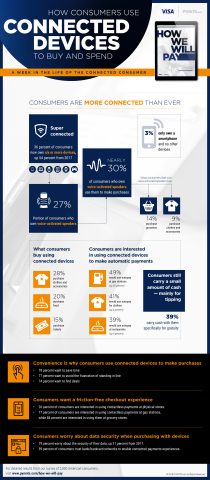Study Finds Surge in Voice-based Commerce Adoption
10/22/2018
“How We Will Pay” study explores how payments by connected devices are becoming a natural extension of consumers’ daily lives
This press release features multimedia. View the full release here: https://www.businesswire.com/news/home/20181022005329/en/

Results of Visa and PYMNTS.com's second annual "How We Will Pay" study. (Graphic: Business Wire)
“When consumers use Visa, they can trust that their payments will be simpler and more secure,” said TS Anil, global head of payment products and platforms, Visa. “By working with EMVCo® to create and support new standards, we are increasing security and consistency in the consumer payment experience, no matter where or how someone chooses to pay, whether online, in stores or increasingly just by voice.”
In recent years, there has been an onslaught of new ways to pay that go far beyond the card and make digital payments much more accessible. Consumers now seem to be taking notice. The study found that over a seven day period, more than half of consumers made an online purchase in more than half of the categories tracked (e.g., groceries, clothing, etc.), citing the main reason as a desire to save time and eliminate the frictions associated with buying and paying in the physical world.
The full study is available here and additional key findings include:
- The rise of voice commerce: Ownership of voice-activated speakers surged by 88 percent year-over-year – from 14 percent in 2017, to 27 percent in 2018. Groceries (five percent) and food delivery (four percent) were the most popular categories in which early-adopters used voice-based commerce to eliminate friction from routine shopping experiences.
- Younger millennials edged out in being “most connected”: Bridge Millennials (30-40 years) and early Gen X’ers (40-50 years) have surpassed younger generations to become the “Super Connected.” Age is not the only surprisingly fact about these hyper-connected owners of six or more devices: the “Super Connected” group is 57 percent female, 43 percent male.
- Why pay by device vs. card?: Saving time (77 percent) remains the leading reason to use connected devices for payments, followed by 74 percent who said the convenience “improved their quality of life.” Gas, parking, restaurants and clothing were all categories in which more than half of surveyed consumers say they would prefer to use a more automated payment method than they use today.
- Tapping to pay viewed as fast and convenient: With contactless payments increasingly becoming the preferred way to pay at checkout around the world, U.S. consumers cited a desire to tap to pay over swiping a card for the speed and convenience contactless card payments deliver. Nearly two-thirds also said they are familiar with the contactless payment symbol, indicating you can tap to pay with a contactless-enabled card, phone or wearable device.
- Consumers carry less and less cash: The study found that almost half of respondents carry between
$10-$50 in cash (47 percent), followed by 20 percent who carry only$0-$10 . The top reason for carrying any cash is for tips (39 percent), followed by for use with cash-only small businesses (25 percent). - Faster access to earnings in demand: Nearly 70 percent of consumers say that they would like to be paid their salaries weekly or in real time, rather than the standard bi-weekly/monthly pay cycle, citing a better ability to pay bills (53 percent) and manage cash flow (53 percent).
- Security remains top of mind: With the growing use of and dependence upon connected payments, concerns over data security and privacy were up by 11 percent over last year.
Through an evolving and multi-layered approach, Visa strives to expect the unexpected, constantly monitoring the system and sharing intelligence with partners to identify and stop fraud. One of the security technologies Visa has been excited to advance is tokenization. Visa made significant progress since the launch of Visa Token Service in 2014, with a major extension announced just last week.
Methodology
The “How We Will Pay” study, a PYMNTS.com and Visa collaboration, asked consumers to respond to a variety of questions about behavioral patterns, buying habits and shopping preferences related to connected commerce. The study was conducted among approximately 2,800 adult respondents ages 18 and older within the United States by PYMNTS.com on behalf of Visa in
View source version on businesswire.com: https://www.businesswire.com/news/home/20181022005329/en/
Source:
Visa Inc.
Kryssa Guntrum, 415-805-4488
kguntrum@visa.com